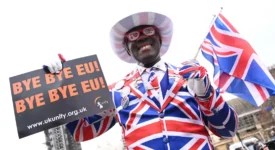As Black Lives Matter protests against racism and calling for justice for George Floyd have been taking place across Europe in countries like the UK, Belgium, Spain, Italy and Denmark, they point to the continent’s dire record of race-based violence and discrimination. And although the Dutch Prime Minister, Mark Rutte, and the German Chancellor, Angela Merkel, have acknowledged their countries’ struggle with systemic racism, the European Union leaders‘ condemnations of race-based violence and discrimination have generally been lukewarm and half-hearted. It’s quite telling that one such voice came from Margaritis Schinas, a European Commission Vice-President whose job description is centred on the “promotion of the European way of life”, who complacently claimed that police brutality of the kind witnessed in the United States is “unlikely” to happen in Europe.
In fact, high-level EU response came only after several days of anti-racism marches and rallies across the continent and with ethnic minority Europeans warning „in Europe, we also can’t breathe“, when Josep Borrell, the EU’s foreign policy chief, sought to assure the public that “all lives matter, black lives also matter.” However, with few staff members in EU institutions coming from any of Europe’s ethnic minority groups, Borrell’s words may not sound too convincing. Still, with an estimated 50 million people of a racial or ethnic minority background living in the EU, according to non-governmental sources, representing 10% of the bloc’s population, the tide may slowly be turning. While there only 29 ethnic minority MEPs, or 3% of the total – the number has gone down with the post-Brexit departure of several British MEPs of Asian origin – those elected to the European Parliament in 2019 are self-confident and ready to make their voices heard.
The EU should act out of self-interest, because if it is to have any credibility, at home or globally, it must practise what it preaches on equality and inclusion. It can and must be done, as demonstrated by the angry protests in Europe’s capital cities with their increasingly diverse, multi-ethnic, multi-religious and multiracial societies. Seeing how some of the most visible symbols and vestiges of racism have been removed in London, Brussels and elsewhere, it is obvious that many Europeans want their countries to break away with their darker pasts. In London, the statue of a prominent slave trader was recently removed from outside a museum with local authorities announcing a review of how other monuments and sites should represent “the more troubling part” of the United Kingdom’s history. Also across the Channel, in the Belgian city of Antwerp, the statue of King Leopold II was removed just days after being daubed with paint by anti-racism protesters. But as Pascale Smet, Brussels’ Heritage Minister, Pascale Smet, noted, “You know it’s a double debate. If you take the statue away, you will forget it, if you leave the statue, you have to contextualise it at a minimum.”
Article Tags:
Belgium · Denmark · Europe · George Floyd · Italy · Margaritis Schinas · Mark Rutte · Pascale Smet · racism · Spain · UKArticle Categories:
GREEN & SOCIAL EUROPE






